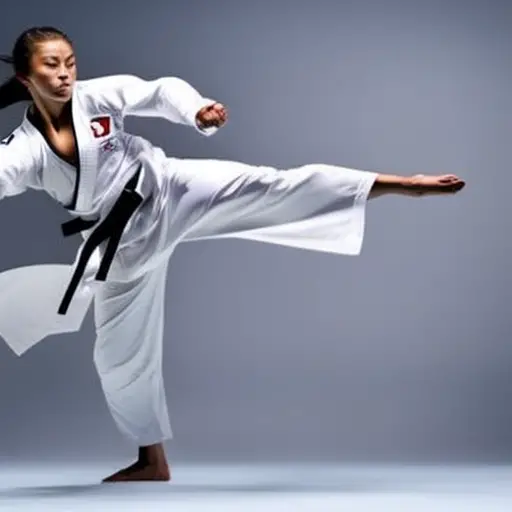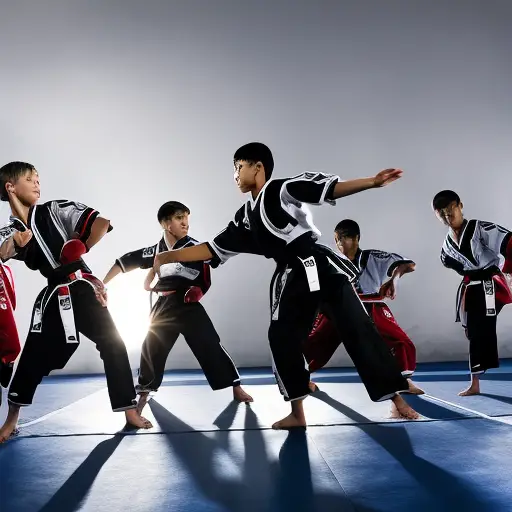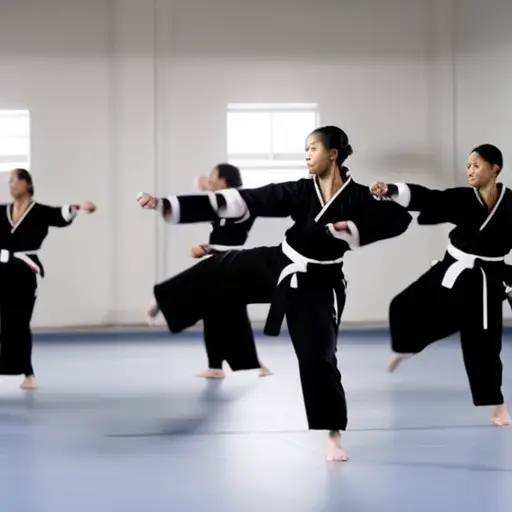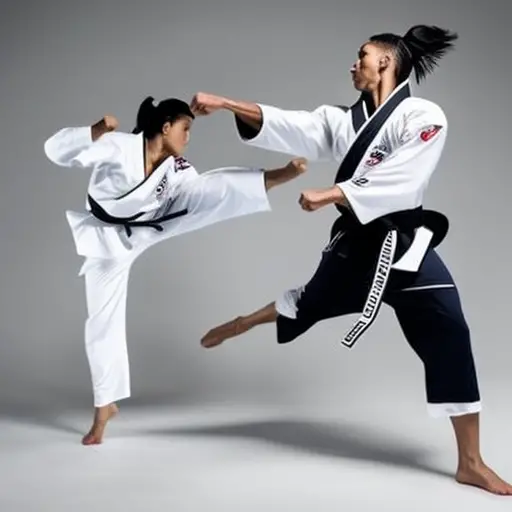Integrating Taekwondo in School PE Programs
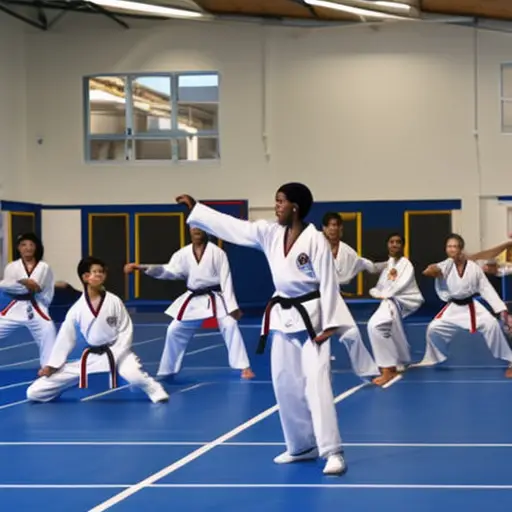
In the realm of physical education, where traditional activities such as soccer and basketball often take center stage, a new contender has emerged to captivate students and invigorate their fitness journey.
Welcome to the world of Taekwondo, a martial art that seamlessly integrates into school PE programs, offering a unique blend of discipline, physical fitness, and self-confidence.
By incorporating Taekwondo techniques and drills into PE activities, educators can create a safe and inclusive environment that challenges students and fosters their personal growth.
The Benefits of Taekwondo in School PE Programs
One of the main benefits of incorporating Taekwondo in school PE programs is that it promotes physical fitness and overall health. Taekwondo is a martial art that requires physical strength, flexibility, and endurance. Through the practice of various techniques and movements, students engage in a full-body workout that helps improve their cardiovascular fitness, muscular strength, and coordination. Additionally, Taekwondo involves intense physical activity, which contributes to burning calories and maintaining a healthy weight.
Moreover, Taekwondo also offers mental benefits to students. The practice of Taekwondo requires focus and concentration, as practitioners must execute precise movements and techniques accurately. By participating in Taekwondo classes, students can enhance their ability to concentrate, which can be transferred to other areas of their lives, including academic performance. Furthermore, Taekwondo is often practiced in a group setting, which promotes teamwork and cooperation among students. By training together, students learn to support and motivate each other, fostering a sense of camaraderie and unity.
In the subsequent section, we will delve into how Taekwondo enhances physical fitness in PE classes. By exploring its specific techniques and training methods, we can gain a deeper understanding of the physical benefits that Taekwondo brings to school PE programs.
How Taekwondo Enhances Physical Fitness in PE Classes
Exploring the various training techniques and exercises of Taekwondo allows for a comprehensive understanding of how this martial art enhances physical fitness in PE classes. Taekwondo is not only a form of self-defense but also a great way to improve overall physical fitness.
Here are four ways in which Taekwondo can enhance physical fitness in PE classes:
-
Improving Coordination: Taekwondo training involves a series of complex movements and techniques that require precise coordination of the body. By practicing these movements regularly, students can improve their coordination skills, which will benefit them in other physical activities as well.
-
Enhancing Flexibility: Taekwondo incorporates various stretching exercises and kicks that promote flexibility. Regular practice of these exercises can lead to increased range of motion and improved flexibility, reducing the risk of injuries and enhancing overall physical performance.
-
Developing Strength and Endurance: Taekwondo involves a combination of aerobic and anaerobic exercises, such as punches, kicks, and sparring. These activities help develop muscular strength and endurance, leading to improved overall fitness levels.
-
Boosting Cardiovascular Fitness: The high-intensity nature of Taekwondo training helps improve cardiovascular fitness by increasing heart rate and improving oxygen utilization. Regular practice of Taekwondo can lead to a healthier cardiovascular system and increased stamina.
Building Self-Confidence Through Taekwondo in PE
The incorporation of Taekwondo into PE classes provides students with significant opportunities to develop and strengthen their self-confidence. Taekwondo is not just a physical activity; it is a practice that encompasses mental well-being as well. Through the practice of Taekwondo, students can build self-confidence by setting and achieving goals, facing challenges, and overcoming obstacles. This martial art requires discipline, focus, and perseverance, all of which contribute to the development of self-confidence.
In Taekwondo, students are encouraged to set personal goals and work towards achieving them. Whether it is mastering a new technique or earning a higher belt rank, the process of setting and achieving goals boosts self-confidence. Additionally, Taekwondo classes often involve sparring and competitions, which provide students with opportunities to face challenges and overcome them. Overcoming challenges not only builds self-confidence but also teaches resilience and determination.
To illustrate the benefits of Taekwondo on self-confidence, let’s take a look at the table below:
| Benefits of Taekwondo on Self-Confidence |
|---|
| Setting and achieving goals |
| Facing and overcoming challenges |
| Building resilience and determination |
| Developing discipline and focus |
| Strengthening mental well-being |
The Role of Taekwondo in Developing Discipline in PE
Developing discipline in PE, taekwondo plays a crucial role in teaching students the importance of self-control and adherence to rules and regulations. Taekwondo is not just about physical techniques and movements; it also focuses on character development and instilling values that promote discipline both inside and outside the training environment.
Here are four ways in which taekwondo contributes to developing discipline in PE:
-
Setting clear expectations: Taekwondo classes have clearly defined rules and regulations that students must follow. This teaches students the importance of discipline and respect for authority.
-
Consistent practice: Taekwondo requires regular and consistent practice to improve skills and techniques. This fosters discipline by teaching students the value of commitment and perseverance.
-
Emphasizing self-control: Taekwondo teaches students to control their actions and emotions, promoting self-discipline. By learning to regulate their behavior, students develop discipline that can be applied to various aspects of their lives.
-
Conflict resolution: Taekwondo emphasizes the importance of resolving conflicts peacefully. Through techniques like sparring and self-defense training, students learn to control their aggression and find non-violent solutions to conflicts. This promotes discipline by teaching students the value of self-restraint and peaceful resolution.
Integrating Taekwondo Techniques and Drills in PE Activities
Integrating Taekwondo techniques and drills in PE activities can bring numerous benefits to students. By incorporating these martial arts elements, students can improve their physical fitness, coordination, and self-defense skills.
Practical implementation strategies, such as incorporating Taekwondo movements into warm-up exercises or creating specific drills for different age groups, can ensure a successful integration of Taekwondo in school PE programs.
Benefits of Taekwondo Integration
An effective way to enhance physical education programs is by incorporating taekwondo techniques and drills, providing numerous benefits for students. Integrating taekwondo into PE activities not only improves physical fitness but also offers mental benefits and can positively impact academic performance.
Here are four key advantages of taekwondo integration:
-
Improved focus and discipline: Taekwondo requires concentration and self-control, helping students develop better focus and discipline, which can translate into improved academic performance.
-
Increased self-confidence: By mastering taekwondo techniques and achieving belt promotions, students gain self-confidence, which can positively impact their overall self-esteem and academic success.
-
Stress reduction: The practice of taekwondo promotes stress relief and emotional well-being, allowing students to better manage the pressures of school and improve their mental health.
-
Enhanced problem-solving skills: Taekwondo requires strategic thinking and quick decision-making, fostering problem-solving skills that can be applied to academic and real-life situations.
Practical Implementation Strategies
To effectively incorporate taekwondo techniques and drills in PE activities, schools can utilize a variety of practical implementation strategies.
One key strategy is curriculum modification, where the existing PE curriculum is adjusted to include taekwondo-specific activities and exercises. This can involve incorporating taekwondo techniques into traditional sports or designing new activities that focus solely on taekwondo movements. By modifying the curriculum, schools can ensure that students receive a well-rounded physical education experience that includes the benefits of taekwondo training.
Another important strategy is instructor support. Schools can provide training and resources for PE instructors to become familiar with taekwondo techniques and drills, enabling them to effectively teach these skills to students. This support can include workshops, online training, or collaborating with local taekwondo studios to provide expert guidance.
Creating a Safe and Inclusive Taekwondo Environment in PE
Effectively creating a safe and inclusive Taekwondo environment in PE is crucial for the overall success and positive experience of all students. Inclusive teaching methods, adaptability, and modifications are key factors in ensuring that every student feels valued and supported in their Taekwondo journey.
To create a safe and inclusive environment in PE, consider the following strategies:
-
Inclusive Teaching Methods: Utilize teaching methods that cater to different learning styles and abilities. Incorporate visual, auditory, and kinesthetic elements to engage all students. Encourage peer collaboration and group activities to foster teamwork and inclusivity.
-
Adaptability: Recognize and address individual differences in physical abilities and adjust the intensity or complexity of exercises accordingly. Provide alternative options or modifications for students who may require additional support or have specific needs.
-
Modifications: Offer modifications to Taekwondo techniques to accommodate students with physical limitations or disabilities. Provide equipment such as padded gloves or target boards to ensure safety and enable participation for all students.
-
Positive Reinforcement and Encouragement: Create a supportive and encouraging environment where all students feel valued and motivated to participate. Celebrate individual progress and achievements to boost self-confidence and foster a sense of belonging.
Overcoming Challenges and Implementing Taekwondo in PE Programs
Implementing Taekwondo in school PE programs can present a variety of challenges, but with the right strategies, training, and techniques, these obstacles can be overcome.
One important aspect is curriculum adaptation, which involves tailoring the Taekwondo curriculum to fit the specific needs and abilities of the students.
Additionally, providing comprehensive instructor training is crucial to ensure that instructors have the necessary knowledge and skills to effectively teach and supervise Taekwondo classes.
Lastly, engaging students through interactive and fun activities can foster their interest and participation in Taekwondo.
Curriculum Adaptation Strategies
One of the key challenges faced when integrating Taekwondo into school PE programs is finding effective curriculum adaptation strategies that address the unique needs and limitations of students. Taekwondo is a martial art that requires discipline, focus, and physical coordination.
To successfully implement Taekwondo in PE programs, educators can utilize the following adaptation techniques:
-
Modified movements: Simplify complex techniques to ensure students can grasp the basics and progress gradually.
-
Inclusive modifications: Consider individual abilities and provide alternative exercises for students with physical limitations or disabilities.
-
Progression levels: Implement a structured curriculum that allows students to advance at their own pace, ensuring both challenge and success.
-
Integration with other subjects: Incorporate Taekwondo principles into other areas of the curriculum, such as character education or cultural studies.
Instructor Training Requirements
To successfully integrate Taekwondo in PE programs, instructors must undergo specific training requirements and overcome various challenges. Instructor certification and teaching qualifications are essential for ensuring that the instructors have the necessary knowledge and skills to effectively teach Taekwondo to students. Obtaining instructor certification typically involves completing a training program that covers the fundamental principles, techniques, and teaching methodologies of Taekwondo. In addition to certification, instructors should also possess teaching qualifications, which may include a background in physical education or experience in teaching martial arts.
Overcoming challenges in implementing Taekwondo in PE programs may involve adapting the curriculum to suit the needs and abilities of the students, addressing safety concerns, and ensuring that the program aligns with the overall goals and objectives of the school. By meeting the training requirements and overcoming challenges, instructors can create a positive and engaging learning environment for students to learn and enjoy Taekwondo.
Transition: Once the instructors have completed their training and are equipped with the necessary skills and knowledge, they can then focus on implementing student engagement techniques to enhance the learning experience.
Student Engagement Techniques
Engaging students in the practice of Taekwondo requires implementing various techniques that foster their active participation and enjoyment of the martial art. To promote student motivation and ensure effective instructional strategies, the following techniques can be employed:
-
Set clear goals and expectations: Clearly communicate the objectives of each class and what is expected of students in terms of behavior and effort.
-
Incorporate interactive activities: Use games, partner drills, and group exercises to make the learning process more engaging and enjoyable.
-
Provide positive reinforcement: Recognize and reward students’ efforts and achievements, boosting their confidence and motivation.
-
Personalize instruction: Tailor the teaching approach to suit individual student needs, ensuring that each student feels valued and supported.
Frequently Asked Questions
What Is the History and Origins of Taekwondo?
The history and origins of Taekwondo can be traced back to ancient Korean martial arts, with influences from Chinese and Japanese fighting styles. It has evolved over centuries, ultimately becoming an Olympic sport and a popular form of self-defense worldwide.
Are There Any Age Restrictions for Students Participating in Taekwondo in PE Programs?
Age restrictions for students participating in Taekwondo in PE programs vary depending on the school’s policies and the instructor’s expertise. However, the benefits of Taekwondo in PE programs include physical fitness, discipline, and self-confidence development.
How Can Taekwondo Be Incorporated Into PE Programs That Have Limited Space or Resources?
To incorporate Taekwondo into PE programs with limited space or resources, modifications can be made such as using smaller mats or practicing in smaller groups. The benefits of Taekwondo in PE include improved physical fitness, discipline, and self-confidence.
What Are Some Common Misconceptions or Stereotypes About Taekwondo That Teachers Should Be Aware Of?
Misconceptions and stereotypes surrounding Taekwondo can hinder its integration into school PE programs. Educators should be aware of the belief that it promotes violence and aggression, while in reality, it teaches discipline, respect, and self-control.
Are There Any SPEcific Certifications or Qualifications Required for PE Teachers to Teach Taekwondo in School Programs?
Certification requirements and qualifications for PE teachers to teach Taekwondo in school programs vary depending on the jurisdiction. Training programs and competency standards are typically established by national or regional Taekwondo governing bodies.
Conclusion
In conclusion, integrating Taekwondo in school PE programs offers numerous benefits for students. It enhances physical fitness, builds self-confidence, and develops discipline. By incorporating Taekwondo techniques and drills into PE activities, students can improve their overall physical skills and learn valuable life lessons.
Creating a safe and inclusive environment for Taekwondo in PE is crucial to ensure that all students can participate and thrive. Overcoming challenges and implementing Taekwondo in PE programs will ultimately contribute to the holistic development of students, both physically and emotionally.
As the saying goes, ‘In the midst of difficulty lies opportunity,’ and integrating Taekwondo in school PE programs presents an opportunity for students to grow and succeed.

